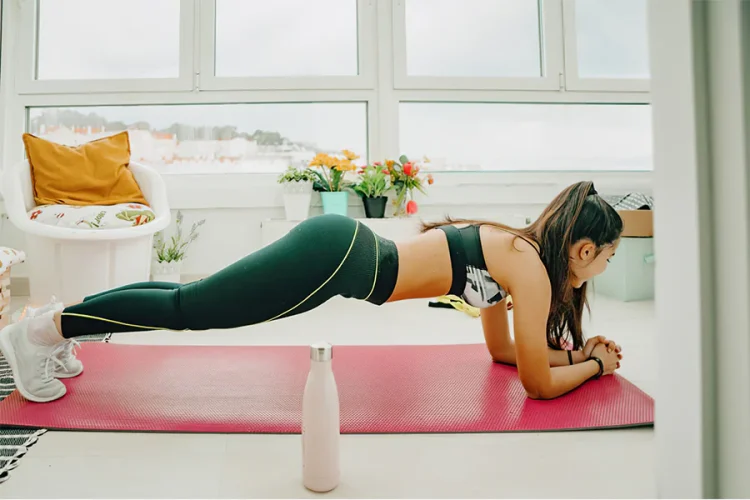The Ultimate Guide to Abdominal Home Workouts

enhances physical appearance but also supports overall fitness, stability, and functional strength. This guide delves into the importance of abdominal training, various effective exercises, how to create a structured workout plan, and tips for maximizing results—all from the comfort of your home.
Table of Contents
ToggleThe Importance of Core Strength
What is the Core?
The core consists of the muscles in your abdomen, back, hips, and pelvis. While most people associate abdominal strength with the rectus abdominis, or the “six-pack” muscles, the core is a complex group of muscles that includes:
- Transverse Abdominis: The deepest layer of abdominal muscles that stabilizes the pelvis and spine.
- Rectus Abdominis: The muscle that forms the “six-pack” and is responsible for flexing the spine.
- Obliques: Located on the sides of the abdomen, these muscles help with rotation and lateral flexion.
- Erector Spinae: A group of muscles that run along the spine, providing support and stability.
Why is Core Strength Important?
- Improved Posture: A strong core helps maintain proper alignment of the spine, reducing the risk of back pain and enhancing overall posture.
- Enhanced Athletic Performance: Core strength is essential for virtually every sport, contributing to improved balance, stability, and power.
- Injury Prevention: A strong core helps support the spine during physical activities, minimizing the risk of injuries.
- Better Balance and Stability: A strong core stabilizes the body during dynamic movements, enhancing overall balance.
- Functional Strength: Everyday activities, such as lifting, bending, and twisting, require a strong core. Strengthening your core can improve your ability to perform these movements safely and efficiently.
Key Principles of Abdominal Training
When designing an effective abdominal workout, consider the following principles:
1. Focus on Form:
Proper form is crucial to avoid injury and ensure effectiveness. Concentrate on engaging the core muscles throughout each movement and maintain a neutral spine.
2. Incorporate Variety:
To develop all areas of the core, include a mix of exercises targeting different muscle groups. Combine flexion, rotation, and stabilization movements to achieve a well-rounded workout.
3. Progress Gradually:
Begin with exercises suited to your current fitness level and gradually increase intensity as your strength improves. This may include adding resistance, increasing repetitions, or trying more advanced variations.
4. Prioritize Consistency:
Consistency is key to achieving results. Aim to incorporate abdominal workouts into your routine at least 2-3 times per week.
Effective Abdominal Exercises
1. Plank Variations
Planks are one of the most effective exercises for building core strength. They engage multiple muscle groups, including the abdominal muscles, shoulders, and glutes.
- Standard Plank:
- Start in a push-up position with your forearms on the ground and elbows directly beneath your shoulders.
- Keep your body in a straight line from head to heels, engaging your core.
- Hold for 20-60 seconds, gradually increasing the duration as you gain strength.
- Side Plank:
- Lie on your side with your legs stacked and elbow directly beneath your shoulder.
- Lift your hips off the ground, creating a straight line from head to feet.
- Hold for 20-60 seconds on each side.
- Plank with Shoulder Taps:
- Begin in a standard plank position.
- While maintaining a stable core, tap your left shoulder with your right hand and then switch sides.
- Perform 10-15 taps per side.
2. Bicycle Crunches
Bicycle crunches effectively target the rectus abdominis and obliques.
- Lie on your back with your hands behind your head and legs lifted, bent at a 90-degree angle.
- Engage your core, lift your shoulder blades off the ground, and rotate your torso to bring your right elbow towards your left knee.
- Straighten your right leg while maintaining the rotation, then switch sides.
- Perform 10-15 repetitions on each side.
3. Leg Raises
Leg raises primarily target the lower abdominal muscles.
- Lie on your back with your legs straight and arms at your sides.
- Engage your core and lift your legs towards the ceiling while keeping them straight.
- Lower your legs back down without touching the floor, maintaining tension in your core.
- Perform 10-15 repetitions.
4. Russian Twists
Russian twists are excellent for building rotational strength in the core.
- Sit on the floor with your knees bent and feet flat.
- Lean back slightly while keeping your back straight, lifting your feet off the ground if possible.
- Hold your hands together or a weight, and rotate your torso to the right, then to the left.
- Perform 10-15 twists on each side.
5. Mountain Climbers
Mountain climbers are a dynamic exercise that also boosts cardiovascular endurance.
- Start in a high plank position with your hands under your shoulders.
- Quickly draw one knee towards your chest, then switch legs in a running motion.
- Keep your core engaged throughout the movement.
- Perform for 30-60 seconds.
6. Dead Bug
The dead bug exercise promotes core stability and coordination.
- Lie on your back with your arms extended towards the ceiling and knees bent at a 90-degree angle.
- Lower your right arm and left leg towards the floor while keeping your lower back pressed into the ground.
- Return to the starting position and switch sides.
- Perform 10-15 repetitions on each side.
Sample Abdominal Home Workout Routine
Here’s a sample 20-30 minute abdominal workout that you can do at home, requiring no equipment:
Warm-Up (5-10 Minutes)
- Jumping jacks – 2 minutes
- Arm circles – 1 minute
- Torso twists – 1 minute
- High knees – 1 minute
Workout (15-20 Minutes)
- Plank: 30 seconds
- Bicycle Crunches: 15 repetitions per side
- Leg Raises: 15 repetitions
- Russian Twists: 15 repetitions per side
- Mountain Climbers: 30 seconds
- Dead Bug: 15 repetitions per side
Cool Down (5 Minutes)
- Cat-Cow stretch – 1 minute
- Child’s pose – 1 minute
- Seated forward fold – 1 minute
- Supine spinal twist – 1 minute per side
Repeat the workout 2-3 times per week, and feel free to adjust repetitions and durations as needed.
Tips for Maximizing Results
- Nutrition Matters: A balanced diet is essential for reducing body fat and revealing abdominal muscles. Focus on whole foods, lean proteins, healthy fats, and plenty of fruits and vegetables.
- Stay Hydrated: Proper hydration is crucial for overall health and can improve performance during workouts.
- Rest and Recovery: Allow your muscles time to recover between workouts to avoid overtraining and injuries. Aim for at least one rest day per week.
- Listen to Your Body: If you experience pain or discomfort during exercises, stop immediately. Modify movements as necessary to suit your fitness level.
- Track Your Progress: Keep a journal of your workouts, noting the exercises performed, sets, repetitions, and duration. Tracking progress can help you stay motivated and make necessary adjustments.
- Combine with Full-Body Workouts: While targeting the core is important, integrating full-body workouts into your routine can enhance overall strength and fitness.
Common Mistakes to Avoid
- Relying on Crunches Alone: Many people mistakenly think that doing countless crunches will yield visible abs. While crunches are effective, a well-rounded approach is necessary.
- Neglecting Proper Form: Improper form can lead to injury and limit the effectiveness of exercises. Always prioritize form over the number of repetitions.
- Ignoring Nutrition: Abs are made in the kitchen. A poor diet can hinder progress despite a rigorous workout routine.
- Training the Same Muscles Every Day: Muscles need time to recover. Avoid doing abdominal workouts daily; instead, incorporate core training into a balanced routine.
Conclusion
Abdominal workouts can be performed effectively at home, making them accessible to anyone looking to strengthen their core. By focusing on proper form, variety, and consistency, you can achieve your fitness goals. Remember to complement your workouts with a balanced diet and adequate recovery. With dedication and the right approach, you can build a strong, stable core that enhances your overall fitness and well-being. Start your journey today, and enjoy the benefits of a powerful core!





